![]()
Test 1 Autumn 2000
|
|
|
|
Test 1 Autumn 2000 |
|
1. (20 points) A rocket moves upward from the ground starting with an initial velocity of 50.0 m/s. It moves upward with an acceleration of +29.4 m/s2 for 4.00 seconds. It runs out of fuel at 4.00 seconds where its velocity is V2. It continues to move upward in free fall (a = -g) for a while until it reaches it's maximum height where its velocity is V3 = 0. See the diagram below showing this situation.
(a) (10 points) What is the height (in meters) of the rocket above the ground at 4.00 seconds ?
(b) (3 points) What is the velocity V2?
(c) (7 points) What is the total height ( in meters) of the rocket above the ground when its velocity is V3 = 0?
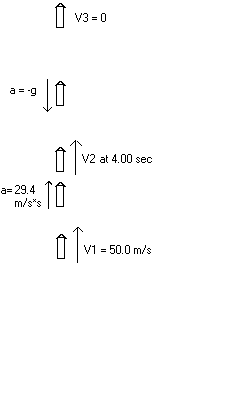
|
Solution Outline: See Quiz 1. Problem 40, Ch. 2. I just
changed it a little bit by giving the rocket an initial velocity. Suprise! (c) V32 = V22 - 2g(y3 - y2) so that y3 - y2 = 1433.15 m . So the total height = 1433.5 + 435.2 = 1868.35 m |
2. (20 points)
A child starts from the front door of her playhouse and follows the route shown in the above figure. Her first displacement has magnitude 6 m at 30 degrees with the horizontal and her second displacement has magnitude 40 m with an angle of 45 degrees with vertical.
(a) (10 points) What is the magnitude of the resultant displacement?
(b) (10 points) What is the value of the reference angle that the displacement makes with the x-axis?
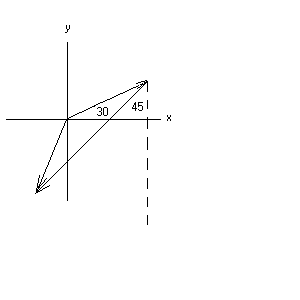
|
Solution Outline: See Sample Exam! (a) Cy = 6sin30 - 40sin45 = -25.28 m Cx2 + Cy2 = C2 . Thus C = 34.22 m |
3. (20 points)
A pitcher throws a ball horizontally with speed Vo. The ball drops 0.500 m to the
ground when it reaches the home plate. The home plate is located a horizontal distance of
20.0 m from the pitcher .
(a) (15 points) What is Vo ?
(b) (3 points) What is the y-component of velocity of the ball when it hits home plate?
(c) (2 points) What is the speed of the ball when it hits home plate?
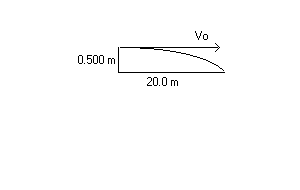
|
See #16, #17, and #18 of Quiz 2 in Ch. 3. 0.500 m = (1/2)gt2. Thus t = 0.319 sec Thus V0x = V0 = 20 m/0.313 sec = 62.50 m/s (b) Vy = Voy - gt = 0 - gt = -(9.8)(0.313) = - 3.13 m/s (c) V2 = Vx2 + Vy2 = 62.22 + (-3.13)2 . Thus, V = 62.6 m/s |
4. ( 20 points) Two masses are connected by a string over a pulley as shown in the diagram below. The 2.0 kg mass on the horizontal part of the surface moves to the right, and thus the 8.0 kg mass on the incline moves down the incline. No friction!!
(a) (15 points) What is the acceleration a of the masses?
(b) (5 points) What is the tension T in the string?
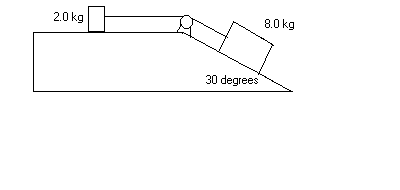
|
Solution Outline: See all force problems on Quiz 3. This problem is a combination of all the problems you had with objects connected by strings. I am testing you on your basic knowledge of a simple problem without friction. Add the two equations to get: (b) ma = T = (2 kg)(3.94 m/s2) = 7.84 N |
5. Extra Credit. ( 11 points) A 1.00-kg block is under the influence of a horizontal force of magnitude F = 20.0 N over a distance 5.0 m. The coefficient of kinetic friction is 0.10.
(a) ( 3 points) What is the work done by the force of magnitude F?
(b) ( 6 points) What is the work done by friction ?
(c) ( 2 points) If the box starts from rest, what is the speed of the box after is moves a horizontal distance 5.00 m?
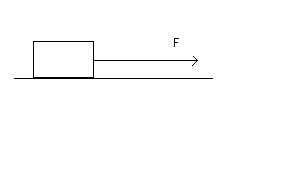
|
Solution Outline: See sample exam! (a) WF = Fdcos0 = 100 J (c) (1/2)mVf2 - (1/2)mVi2 = WF + Wf Vf = 13.79 m/s |